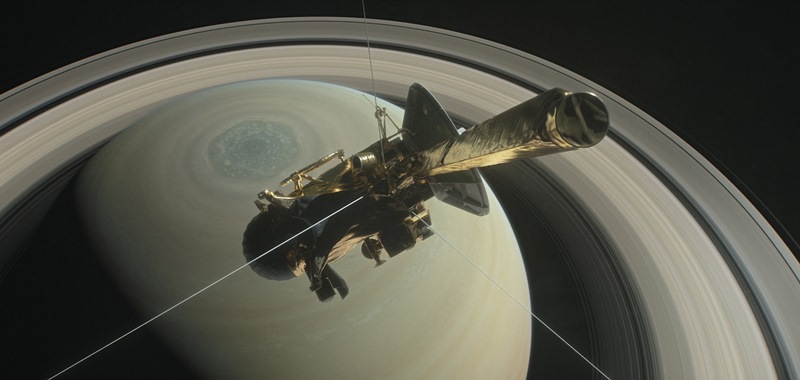Aberystwyth space scientists follow Cassini’s final hours

Cassini: The space craft will end its twenty year mission to Saturn on Friday 15 September – Image courtesy of NASA/JPL-Caltech
13 September 2017
Space scientists at Aberystwyth University are following the progress of the Cassini spacecraft as it nears the end of its twenty year mission to the planet Saturn.
Professor Manuel Grande from the Department of Physics at Aberystwyth University is co-investigator on three scientific instruments on board the craft which is due to plunge into the Saturn atmosphere on Friday 15 September 2017.
Launched from Cape Canaveral in October 1987, Cassini and the European Space Agency probe Huygens took seven years to reach the ringed planet.
Huygens landed successfully on one of Saturn’s moons, Titan in 2005.
Named after the Italian-French astronomer Giovanni Domenico Cassini, who discovered Saturn’s rings, one of the Cassini space probe’s objectives was to determine the three-dimensional structure and dynamic behaviour of the rings.
In April 2017, Cassini embarked on a final programme of 22 orbits of Saturn, each taking about six and half days to complete.
Travelling at between 75,000 and 78,000 miles per hour, the probe has been flying through a hitherto unexplored region of the Saturnian system in an attempt to solve the mysteries of the mass of Saturn’s rings and determine the length of Saturn’s day.
Professor Manuel Grande, Head of Solar Systems Physics at Aberystwyth University has been involved with the Cassini mission from an early stage.
He contributed to building Cassini’s Plasma Spectrometer, known as CAPS, and its Cosmic Dust Analyser - CDA.
Professor Grande explains: “CAPS measures the properties of the space around Saturn and around the moons of Saturn – the charged particles, the electrons, the ions and to some extent the neutral atoms as well. This tells us about the dynamics of the particles that go into the aurora on Saturn – a phenomenon similar to the northern lights as seen near the poles on earth.
“Saturn has a big magnetic field, similar to earth; it has rings and moons which together create a tremendously complicated environment. The physics is always the same, but the outcome is sometimes very different, rather like baking a cake. CAPS is a collection of scientific instruments designed to diagnose that complicated behaviour in the space around the planet.”
Speaking of the mission’s Cosmic Dust Analyser, Professor Grande said: “Because you’ve got rings, you have dust which interacts with the plasma. Before the launch I was more interested in the lander itself and the plasma analyser, but in retrospect, I actually think that the cosmic dust analyser has been one of the stars of the Cassini mission because it has been able to fly through the plumes of the Enceladus, Saturn’s sixth-largest moon, and tell us what they are made of.
“One of the most startling discoveries of Cassini has been that Enceladus has a liquid water ocean under its ice surface, and that this ocean contains salts and organic molecules.
“So we actually know a great deal about what the inside of Enceladus is made of because we are able to analyse the dust probes. It is an instrument that has come into its own in the last couple of years, which, for a mission this long, is just amazing.”
Professor Grande added: “The data gathered during the Cassini mission has changed our understanding of the universe. Another important instrument on the lander has been the camera on the Huygens probe as it descended towards the surface and complemented with the radar on the Cassini orbiter. That has given us a picture of the surface of Titan, which has been very surprising.”
“It turns out that Titan has got big lakes, sand dunes and rivers which from space look pretty much like rivers on earth. It’s also got seasons. In many ways it’s the place in the solar system that if you just look at it, looks most like the earth. The difference is that it is much much colder, and the liquid is liquid methane similar to that in camping gas cylinders, and the rocks are ice. That is completely surprising because before we went to Titan, we had never seen under the atmosphere. So it tells us there is great argument for going to new places, and when we do, we find out new and unexpected things.”
Professor Grande’s principal research interests are in the study of planetary surfaces and their interaction with their plasma environment principally using data from the Indian Space Research Organisation led Chandrayaan-1 mission to the moon, the European Space Agency’s Venus Express mission and the Cassini mission.
One feature of the Aberystwyth involvement in Cassini has been that the data is available for use in undergraduate projects.
To learn more about studying a BSc (three year) and MSc (four year) degrees in Physics and Planetary Physics at Aberystwyth University click here.



